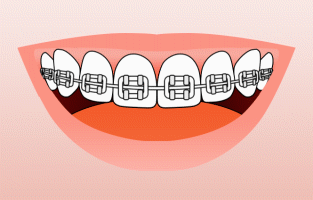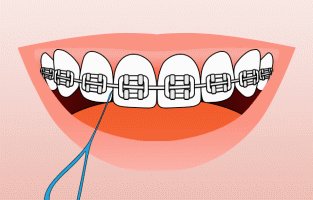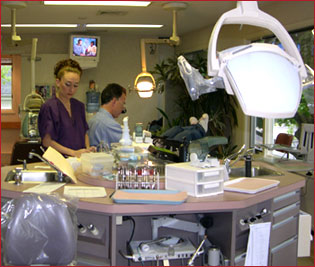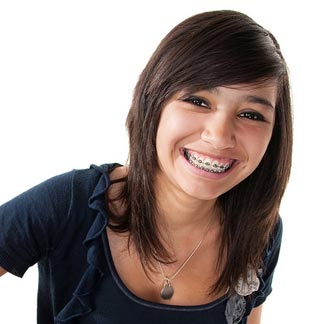Life with Braces
Regular and Broken Appointments
Your appointments will vary in time. The appointment to get your braces on usually takes from 60-90 minutes. You'll then see us at regular intervals 4 - 6 weeks apart for an adjustment, which usually takes 10-20 minutes. If an appointment will be longer we will try to inform you of this at the time of scheduling your next appointment. Patients are seen by appointment only. We make every effort to be on time for you, and ask that you extend the same courtesy to us. If for some reason you cannot keep your appointment, please contact our office immediately. If it is after hours, please leave your name and number and a brief message on our voice mail and we will return your call the next morning. Try to cancel only if it is an emergency. Appointments are scheduled for you on the 4 - 6 week interval and therefore rescheduling can become difficult. However, we will always do our best to accommodate you.
Length of Treatment
Braces may be on between 6 months to 30 months, or longer depending on the age of the patient, the severity of the problem and the degree of movement. During this time, you will need to keep appointments, follow instructions, as well as practice good oral hygiene and proper nutrition. Also continue to visit your dentist regularly. Once your braces are removed, retainers are utilized to hold your teeth in their new positions until your bone, gums, and muscles adapt to the new teeth positions.

Dental Care
Before any orthodontic treatment, your family dentist should make certain that all cavities have been treated and the health of your gums and underlying bone are free of periodontal disease. Your family dentist should also schedule cleaning and cavity checkup visits during your orthodontic care. It is important to keep your regular visits with your family dentist. We are an addition to your family dentist, not a replacement. Please contact our office if you have any questions.
Eating Habits - Foods to Avoid
A healthy diet means a healthy body, healthy teeth, and a better result for your orthodontia. Please do not eat hard foods: nuts, ice, crisp taco shells, whole apples and carrots (cut them into pieces first), hard French bread crust and rolls, spareribs, and unpopped popcorn kernals. These foods risk breaking brackets and wires. Also beware of nail biting and pen or pencil chewing habits, since these can also damage your braces. Do not eat sticky foods: taffy, caramels, bubble gum, sticky candy of any sort. A small piece of sugarless gum occasionally is acceptable. Use common sense about most foods. Remember that if you do break off a bracket it will extend your treatment time. As long as there is a loose bracket the tooth will not move.
Foods to avoid while wearing braces:
- Gummy Bears - Although these are not hard, they are sticky and will cause bands to loosen up and pull separators out.
- Chewing Cracked Ice - A big no-no! This can crack the cement, which bonds the braces to the teeth.
- Hard Pretzels
- Hard Pizza Crust and Hard Bread Crust-It is the crust itself and not the pie. Just avoid the hard edges.
- Apples (unless peeled and cut into bite sized pieces)
- Carrots (unless cut in strips)
- Popcorn - If the little shells get between your braces and your gums you are in for an infection. They don't come out on their own so best to stay away from it.
- Frozen Candy Bars
- Nuts
- Hard Candies - Anything that is hard will cause damage.
- Sticky Candies - Although these are not hard, they are sticky and will cause bands to loosen up and pull separators out.
- Meat on the Bone
- Beef Jerky - Not only is it bad for your teeth and jaws, it will break brackets too.
- Celery
- Granola Bars
- Bubble Gum
- Tootsie Roll / Bit-O-Honey
- Crunchy Chips - If it makes a crunch when you bite down, it is best to stay away from these foods.
The intended animation requires a newer version of Adobe Flash® Player. Please visit www.adobe.com to download the latest version.
Brushing Your Teeth with Braces
When you have braces, it's very important to brush and floss after every meal in order to keep your teeth and gums healthy throughout your orthodontic treatment. If you need help choosing the right toothbrush, toothpaste, and dental floss, please ask us and we can help you choose the right products for your teeth and your appliance.
Brushing with Braces
Brush your teeth for two minutes after every meal with a soft-bristled, small-headed toothbrush and fluoride toothpaste. As an alternative, you can use a powered toothbrush to increase your brushing effectiveness. Brush the outside and inside surfaces of your teeth using small, gentle, circular motions while positioning the head of the toothbrush at a 45-degree angle to the gum line. Brush your teeth’s chewing surfaces and the inside surface of your front teeth using short, gentle, back-and-forth motions. Pay close attention to the areas around your brackets or other appliances.

Flossing with Braces
Flossing after every meal will help keep your teeth and braces clean, which will also help keep your treatment time on track. To floss with braces, use a floss threader or special orthodontic floss to thread the floss behind each wire. Wrap the ends of the floss around your pointer fingers of both hands, leaving a few inches of taught floss between them. Gently slide the floss between each set of teeth using a back and forth motion. Floss the sides of each tooth beneath the gum line to remove plaque and food particles. Repeat this process until you’ve flossed all of your teeth. If you find that your floss is not removing all of the food particles between your teeth and around your braces, ask us about a water flosser!

You will notice that it requires more time to keep your teeth clean with braces. Food tends to get stuck in the brackets and between your teeth, and can only be removed by brushing and flossing. Floss every day. In order to get the floss under your wires, use floss threaders. If plaque remains on the teeth for any length of time, it will leave a permanent white scar on the surface. Brushing after meals should become part of your daily schedule. Make sure to use the special fluoride gel prescribed by your orthodontist every day. It will not only prevent cavities, but also help prevent decalcification around the brackets of your braces.
Elastics
Elastics (rubber bands) exert the proper force that creates the right amount of pressure to move teeth. In order for this force to remain constant, elastics must be worn all the time and changed once a day. Any time missed in wearing your elastics will only make your treatment take longer, so remember these things:
- You are responsible for placing the elastics on your braces between appointments. Make sure to wear them as instructed. Remove them only when brushing your teeth, gums and braces after meals. Then put your elastics back on immediately.
- Always carry a few elastics with you, so if one breaks you can replace it right away. If your supply is low, call the office and we will mail you an additional supply of elastics.
- If you forget to insert your elastics one day, do not double up the next day, just follow your regular instructions.
- Elastics become worn out. When they lose their elasticity, they do not provide the proper pressure on your teeth and jaws. It is very important to change them as directed, even when they are not broken.
- If your elastics break frequently, a wire or band loosens, or a hook breaks off call our office immediately. Do not wait until your next appointment. These problems need to be corrected as soon as possible.

Removable Appliances
The removable appliance is carefully designed to move or to hold your teeth. It is important that it is worn according to instructions and brought to each appointment.
You must wear your appliance at all times, even while you are asleep. It may be removed while eating, swimming, or playing vigorous sports activities.
Avoid flipping your appliance with your tongue. This can cause damage to your teeth or breakage of your appliance.
Your new appliance may make your teeth sore for a day or two, especially after an adjustment. If you have a sore spot on you gums, call our office so that we can adjust the appliance.
Clean your appliance by brushing it daily with toothpaste. Denture cleaner (e.g., Efferdent, Fixodent or Polident) can also be used for a more thorough cleaning. If you are wearing a bonded wire retainer behind your front teeth, be extra careful to clean the wire and the area around it. Flossing should be done every day.
Never wrap your appliance in a paper napkin or tissue and set it down on the table. You or someone else may accidentally throw it away. Do not put it in your pocket when playing or you may break or lose it. Whenever it is not in your mouth, it should be placed in its plastic appliance case.
 Keep your appliance away from dogs or cats, as they love to chew on them. Avoid storing them near any source of heat. Do not boil your retainer to sterilize it. If needed, bring it to the office and we will be happy to disinfect it for you.
Keep your appliance away from dogs or cats, as they love to chew on them. Avoid storing them near any source of heat. Do not boil your retainer to sterilize it. If needed, bring it to the office and we will be happy to disinfect it for you.
The Patient's Responsibility
Please follow these instructions and keep your appointments.
- See your dentist every 6 months.
- Brush your teeth after every meal.
- AVOID eating sweets between meals unless the teeth can be cleaned immediately thereafter.
- AVOID chewing ice, hard or sticky candy, gum, and popcorn, playing with, or dislodging appliances.
- AVOID rough play where you could receive a blow to the face or could catch the appliances upon your clothing and dislodging or breaking them.
- Please notify the office IMMEDIATELY if the appliances are loose, lost or broken.






 Website Powered by Sesame 24-7™
Website Powered by Sesame 24-7™